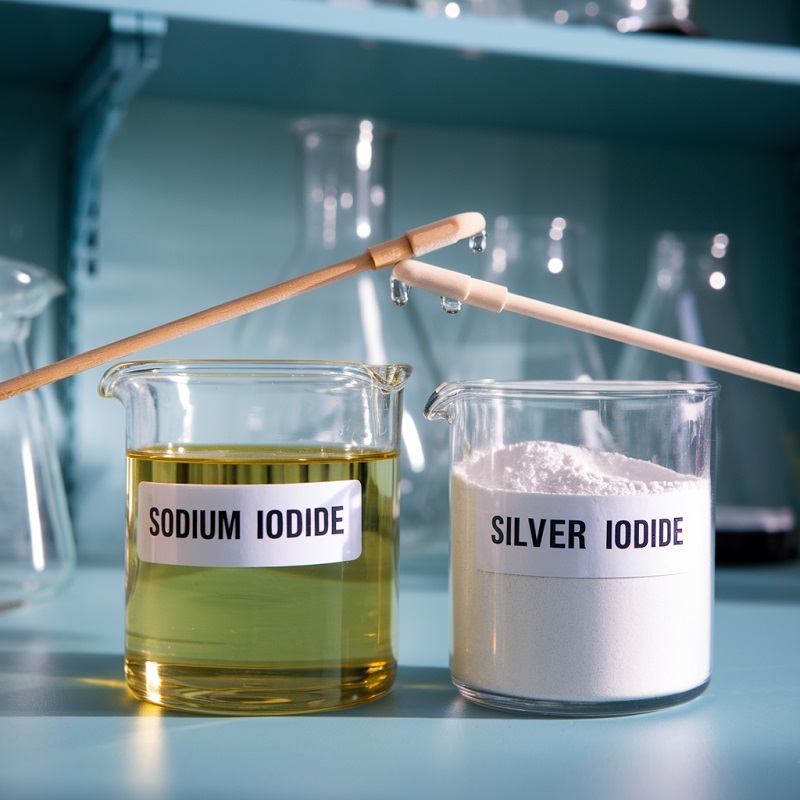
Sodium Iodide versus Silver Iodide for Cloud Seeding is an innovative technique used to enhance precipitation, especially in areas facing drought or water scarcity. The process involves dispersing substances into the air that encourage cloud formation and precipitation. Among the most commonly used agents for cloud seeding are silver iodide and sodium iodide. While both serve the same fundamental purpose, their characteristics, effectiveness, and environmental impacts differ. This article explores the nuances between sodium iodide and silver iodide, delving into their roles in cloud seeding, their pros and cons, and real-world applications.
What is Cloud Seeding?
Cloud seeding is a form of weather modification that involves dispersing substances into the atmosphere to encourage cloud condensation, leading to precipitation. The process has been used for decades to enhance rainfall, reduce hail, and even clear fog. It’s commonly used in areas prone to drought or where water resources are critical.
- How it Works: Cloud seeding involves releasing particles into clouds that act as nuclei around which water droplets can form. These particles enhance the coalescence of water droplets, increasing the likelihood of precipitation.
- Common Substances: The most common substances used for cloud seeding are silver iodide and sodium iodide, each with unique properties.
The Role of Silver Iodide in Cloud Seeding
Silver iodide (AgI) is one of the most widely used agents in cloud seeding. Its effectiveness lies in its ability to mimic ice nuclei, making it ideal for cold cloud seeding.
- Chemical Properties: Silver iodide has a crystalline structure similar to ice, making it effective in cold clouds where temperatures are below freezing.
- Effectiveness: Silver iodide is effective in enhancing precipitation, especially in cold and mixed-phase clouds where ice nuclei are critical.
- Environmental Impact: Concerns have been raised about the environmental impact of silver iodide, particularly its potential toxicity to aquatic life and the broader ecosystem.
Sodium Iodide: An Alternative Approach
Sodium iodide (NaI) is an alternative to silver iodide in cloud seeding. While it is less commonly used, it offers certain advantages, particularly in warm cloud seeding.
- Chemical Properties: Sodium iodide is more soluble in water than silver iodide, which can be advantageous in warm clouds where liquid water predominates.
- Effectiveness: Sodium iodide is effective in warm cloud seeding, where it can promote the growth of water droplets in a different manner than silver iodide.
- Environmental Considerations: Sodium iodide is generally considered less harmful to the environment compared to silver iodide, particularly concerning its lower toxicity.

Comparing Effectiveness: Sodium Iodide vs. Silver Iodide
When comparing sodium iodide and silver iodide, it’s essential to consider their effectiveness in different types of clouds and weather conditions.
| Factor | Silver Iodide (AgI) | Sodium Iodide (NaI) |
| Temperature Range | Effective in cold clouds | Effective in warm clouds |
| Water Solubility | Low | High |
| Ice Nucleation | High (mimics ice nuclei) | Low (better for liquid water) |
| Environmental Impact | Potentially toxic | Less toxic |
| Cost | Higher | Lower |
Real-Time Example: In 2023, during a significant drought in California, both sodium iodide and silver iodide were used in different regions. While silver iodide was effective in higher altitudes, sodium iodide showed better results in the warmer valleys.
Environmental Impact and Safety Concerns
One of the most critical aspects of cloud seeding is its environmental impact. Both sodium iodide and silver iodide have been scrutinized for their potential effects on ecosystems.
- Silver Iodide: Studies have shown that silver iodide can accumulate in the environment, particularly in water bodies, where it may harm aquatic life. However, the concentrations used in cloud seeding are generally considered low and not immediately harmful.
- Sodium Iodide: Sodium iodide is less toxic and more environmentally friendly. However, it is still essential to monitor its long-term effects, particularly in sensitive ecosystems.
Cost Considerations in Cloud Seeding Operations
Cost is a significant factor when choosing between sodium iodide and silver iodide for cloud seeding.
- Silver Iodide: Generally more expensive due to its chemical properties and the complexity of production. It is often used in more targeted operations where specific outcomes are desired.
- Sodium Iodide: Less costly, making it a more feasible option for large-scale operations, particularly in warmer climates.
Cost Analysis Table:
| Cloud Seeding Agent | Cost per Gram | Average Usage per Operation | Total Cost |
| Silver Iodide (AgI) | $5.00 | 100 grams | $500 per operation |
| Sodium Iodide (NaI) | $2.50 | 150 grams | $375 per operation |
Real-World Applications: Case Studies
Cloud seeding has been implemented in various regions with differing outcomes based on the agent used.

Case Study 1: Colorado, USA
The Rocky Mountains in Colorado are a vital water source for much of the western United States, providing critical snowmelt that feeds into rivers, reservoirs, and agricultural areas. Over the years, with the increasing threat of drought and fluctuating weather patterns, Colorado has turned to cloud seeding as a method to enhance snowfall, particularly during the winter months.
Background and Motivation
Colorado’s mountainous regions, particularly the Rocky Mountains, receive significant snowfall annually, which plays a crucial role in the state’s water supply. However, in recent years, concerns have grown over decreasing snowpacks and their impact on water availability. This led to the adoption of cloud seeding programs aimed at increasing the snowpack.
Silver iodide was chosen as the primary cloud-seeding agent due to its effectiveness in cold cloud conditions, which are prevalent in the high altitudes of the Rockies. The goal was to increase the snowpack by enhancing natural precipitation processes, thereby boosting water storage for the spring and summer months.
Implementation
The cloud seeding program in Colorado involved a combination of ground-based generators and aerial dispersal methods:
- Ground-Based Generators: These generators, strategically placed at high altitudes, released silver iodide particles into the atmosphere when the right cloud conditions were present. The particles, acting as ice nuclei, encouraged water droplets in the clouds to freeze and grow, leading to snowfall.
- Aerial Dispersal: Aircraft equipped with flares containing silver iodide flew into or near cloud systems to release the seeding agent directly into targeted areas. This method allowed for greater control over where and when the seeding occurred.
The cloud seeding operations were coordinated with meteorologists who monitored weather conditions to ensure that the seeding occurred at the optimal times, maximizing the effectiveness of the program.
Results and Impact
The use of silver iodide in the Rocky Mountains led to a notable increase in snowfall during the winter months. Studies and measurements taken after the cloud seeding operations indicated that the snowpack in the seeded areas was significantly higher compared to non-seeded areas. On average, the program resulted in an estimated 10-15% increase in snowpack.
- Water Resource Benefits: The enhanced snowpack contributed to increased runoff during the spring melt, which in turn boosted water levels in reservoirs and rivers. This was especially beneficial during years of lower-than-average natural snowfall, helping to mitigate the effects of drought.
- Economic Impact: The increased water availability had a positive impact on agriculture, hydroelectric power generation, and recreational industries, all of which depend on consistent and adequate water supplies.
- Environmental Considerations: While silver iodide was effective, there were ongoing studies to monitor its environmental impact, particularly concerning potential accumulation in soil and water. However, the concentrations used in the seeding operations were considered low enough to minimize significant environmental risks.
Challenges and Lessons Learned
The cloud seeding program in Colorado faced several challenges, including:
- Weather Variability: The effectiveness of cloud seeding is highly dependent on existing weather conditions. There were periods when suitable clouds were scarce, limiting the opportunities for seeding.
- Public Perception: Some communities were skeptical about the impact of cloud seeding, particularly concerning the use of silver iodide. Continuous efforts were made to educate the public about the science behind cloud seeding and its safety.
The cloud seeding efforts in Colorado’s Rocky Mountains using silver iodide proved to be a valuable tool in managing water resources. By enhancing snowfall, the program provided a reliable boost to the snowpack, supporting water availability for various uses throughout the state. This case study underscores the potential of cloud seeding as a supplementary method for water resource management in regions dependent on snowfall.

Case Study 2: Queensland, Australia
Australia’s interior, particularly in the state of Queensland, faces arid and semi-arid conditions, where water scarcity poses significant challenges to agriculture and the broader ecosystem. In response to persistent drought conditions and the need to boost water availability for agricultural production, Queensland implemented a cloud seeding project using sodium iodide as a seeding agent. The aim was to increase rainfall in targeted regions, particularly those crucial for agriculture.
Background and Motivation
Queensland’s interior is characterized by low and highly variable rainfall, making it one of the most drought-prone areas in Australia. The agricultural sector, which is a vital part of Queensland’s economy, heavily relies on consistent rainfall for crop production and livestock farming. Extended periods of drought had led to reduced crop yields, economic losses, and strain on water resources, prompting the government and local stakeholders to explore cloud seeding as a potential solution.
Sodium iodide was chosen for this project due to its suitability for warm cloud seeding. Unlike silver iodide, which is more effective in colder climates, sodium iodide works well in the warm, convective clouds common in Queensland’s interior. The goal was to enhance natural rainfall by increasing the efficiency of cloud formation and precipitation processes.
Implementation
The cloud seeding operation in Queensland utilized both ground-based and aerial dispersal methods, similar to the approach taken in Colorado but adapted for the warmer climate.
- Ground-Based Dispersal: Ground-based generators were positioned in key agricultural regions. These generators released sodium iodide particles into the atmosphere when weather conditions indicated the potential for convective cloud formation. The particles acted as condensation nuclei, encouraging water droplets to coalesce and form raindrops.
- Aerial Dispersal: Aircraft equipped with sodium iodide flares flew through or near the target clouds, releasing the seeding agent directly into the cloud systems. This method was particularly effective in targeting specific areas that required rainfall, such as drought-stricken farmlands.
Meteorologists and weather experts monitored the conditions closely to determine the best times for seeding, ensuring the operations were conducted when the cloud formations were most likely to respond to the seeding process.
Results and Impact
The sodium iodide cloud seeding project in Queensland achieved a moderate but significant increase in rainfall across the targeted areas. Here are some key outcomes:
- Precipitation Increase: The project reported a 5-10% increase in precipitation in the seeded areas compared to non-seeded control regions. This increase was particularly noticeable during periods of marginal weather, where natural rainfall would have been minimal.
- Agricultural Benefits: The enhanced rainfall contributed to improved soil moisture levels, which in turn supported better crop growth and higher yields. Farmers in the seeded areas reported increased productivity, especially in crops that are highly sensitive to water availability, such as wheat and barley.
- Water Resource Management: The additional rainfall also helped replenish local water supplies, including reservoirs and groundwater sources, providing a buffer against ongoing drought conditions.
Environmental Considerations
The use of sodium iodide in cloud seeding raised fewer environmental concerns compared to silver iodide, primarily due to its lower toxicity and higher solubility in water. Environmental monitoring conducted during and after the project found no significant adverse effects on the local ecosystems. The sodium iodide concentrations used were carefully controlled to minimize any potential impact.
However, as with any weather modification project, there was a need for ongoing monitoring to ensure that the long-term accumulation of seeding agents did not lead to unforeseen consequences.
Challenges and Lessons Learned
While the cloud seeding project in Queensland was generally successful, it faced several challenges:
- Weather Dependencies: The effectiveness of the seeding was highly dependent on the presence of suitable cloud formations. In some instances, despite the release of sodium iodide, the weather conditions were not conducive to significant rainfall, leading to variable results.
- Public Perception and Skepticism: Similar to other cloud seeding efforts, there was some public skepticism about the effectiveness of the program and concerns about its environmental impact. Public outreach and transparent communication were crucial in addressing these concerns and gaining community support.
- Cost and Resource Allocation: The project required significant financial and logistical resources, particularly for the operation of aircraft and ground-based generators. Balancing the costs with the benefits of increased rainfall was a key consideration for policymakers.
The cloud seeding project in Queensland using sodium iodide provided valuable insights into the potential of weather modification as a tool for managing water resources in arid and semi-arid regions. While the increase in rainfall was moderate, it was sufficient to make a meaningful difference in agricultural productivity and water availability. This case study highlights the importance of tailoring cloud seeding approaches to the specific climatic conditions of the region and demonstrates the potential benefits of sodium iodide as a cloud seeding agent in warm climates.
The Future of Cloud Seeding: Innovations and Challenges
As climate change continues to impact global weather patterns, cloud seeding is likely to become an increasingly important tool in managing water resources. Innovations in the field are focusing on improving the efficiency and reducing the environmental impact of cloud seeding agents.
- New Materials: Research is ongoing into the development of new seeding agents that are more effective and environmentally benign.
- Technological Advances: Drones and AI-driven systems are being tested to improve the precision and effectiveness of cloud seeding operations.
- Regulatory Challenges: As cloud seeding becomes more widespread, there will be increasing regulatory scrutiny, particularly regarding environmental impacts.
Key Takeaways
- Silver Iodide is highly effective in cold cloud seeding but poses environmental risks and is more costly.
- Sodium Iodide offers a viable alternative, especially in warm cloud seeding, with a lower environmental impact and cost.
- Choosing the Right Agent depends on the specific weather conditions, environmental considerations, and budget constraints.
- Ongoing Research is crucial for developing safer and more effective cloud seeding technologies.
FAQs
Q1: Is cloud seeding safe for the environment?
Cloud seeding is generally considered safe when done correctly, but there are concerns about the long-term environmental impact, particularly with silver iodide.
Q2: Why is silver iodide more commonly used than sodium iodide?
Silver iodide is more effective in cold cloud seeding, which is why it is more commonly used despite its higher cost and potential environmental risks.
Q3: Can cloud seeding solve drought problems?
Cloud seeding can help mitigate drought conditions by enhancing precipitation, but it is not a complete solution to water scarcity issues.
Q4: How much does cloud seeding cost?
The cost of cloud seeding varies depending on the agent used, the scale of the operation, and the technology involved. Silver iodide operations tend to be more expensive than sodium iodide.
Q5: What is the future of cloud seeding?
The future of cloud seeding lies in developing more effective and environmentally friendly agents, as well as incorporating advanced technologies for precision operations.


